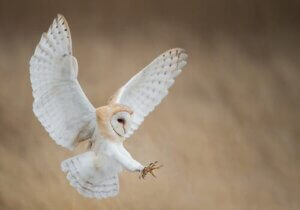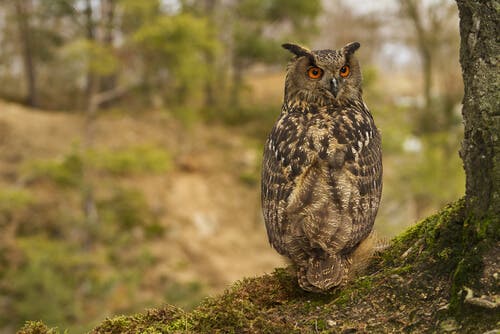Diurnal and Nocturnal Birds of Prey


Written and verified by the lawyer Francisco María García
Diurnal and nocturnal birds of prey seem remarkably similar to the naked eye. However, if you compare and owl and a hawk, there are considerable anatomical and behavior differences. However, all birds of prey have great hunting instincts and sharp senses.
From a taxonomic point of view, diurnal and nocturnal birds of prey also differ from each other. For example, diurnal birds of prey usually belong to the falconiform and accipitriformes families. On the other hand, nocturnal birds of prey are almost always from the strigiform order.
Next, we’ll learn more about birds of the prey and some key differences between diurnal and nocturnal ones.
Shared characteristics
Beyond just appearance, there are essential features that explain why birds of prey resemble each other. Among other things, there’s the fact that they’re all carnivorous.

Birds of prey all have excellent vision. This is important for hunting. In addition, they have strong claws on their legs, which help them to grab and hold their prey. They also have very powerful, hook-shaped beaks.
Their appearance is the result of an adaptive, genetic process called convergent evolution. This means that that different species can develop the same physical characteristics or certain habits that guarantee their survival.
Two animals that are totally different in principle can resemble each other throughout their evolutionary process.

However, if you look at the image of an ancient eagle, for example, you can see many differences to the modern eagle. You can also see how some different species of birds, such as owls and kites, are actually more alike today than they were 100 or 200 years ago.
Differences between types of birds
The morphological differences between diurnal and nocturnal birds of prey are evident. In fact, you can spot them with just simple observation.

Nocturnal birds of prey, such as owls, have stocky bodies and abundant plumage. They also have round heads, large, conspicuous eyes, and almost no necks.
Owls have very particular traits and it’s difficult to confuse them with other types of birds.
On the other hand, diurnal birds of prey have a thinner, “stretched” body. They also have less developed plumage than nocturnal birds.

These birds have a small head, small eyes, and long necks. Their long legs are also more visible and have long claws.
Diurnal and nocturnal birds of prey species
Throughout the world, diurnal birds of prey are much more abundant than nocturnal ones. For example, in Spain alone, there are 150 of nocturnal birds. On the other hand, there are more than 300 species of diurnal birds of prey.
If it’s simple to catalog species of nocturnal birds,then it’s more difficult to identify all species of diurnal birds of prey. Below, we’re going to briefly summarize the main representatives of both types.
Nocturnal birds of prey
The main species of nocturnal birds of prey are owls. Barn owls are a classic example of this species. However, there are many different types of owls.

Here are some of the famous varieties:
- Royal owl
- Long-eared owl
- Tawny owl
- Little owl
- Scops owl
- Boreal owl
- Short-eared owl
Diurnal birds of prey species
As we’ve said, there are many more different species of diurnal birds of prey.

Below, we’ll look at the most common of these imposing birds:
- Vultures: Black vulture, Griffon vulture, Egyptian vulture, and Bearded vulture
- Eagles: Golden eagle, Bonelli’s eagle, Iberian imperial eagle, Booted eagle, Osprey, and Short-toed snake eagle
- Falcons: Eleonora’s falcon, Peregrine falcon, Eurasian hobby, Lesser kestrel, Merlin, and the Common kestrel
- Kites: Black kite and Red kite
- Buzzards: European honey buzzard and Common buzzard
- Accipitridaes: Eurasian sparrowhawk and Northern goshawk
- Harriers: Western marsh harrier, Hen harrier, and Montagu’s harrier
In addition, in the Canary Islands in Spain, you can also find the Canarian Egyptian vulture and the Barbary falcon. These are two very unique types of diurnal birds of prey.
Diurnal and nocturnal birds of prey seem remarkably similar to the naked eye. However, if you compare and owl and a hawk, there are considerable anatomical and behavior differences. However, all birds of prey have great hunting instincts and sharp senses.
From a taxonomic point of view, diurnal and nocturnal birds of prey also differ from each other. For example, diurnal birds of prey usually belong to the falconiform and accipitriformes families. On the other hand, nocturnal birds of prey are almost always from the strigiform order.
Next, we’ll learn more about birds of the prey and some key differences between diurnal and nocturnal ones.
Shared characteristics
Beyond just appearance, there are essential features that explain why birds of prey resemble each other. Among other things, there’s the fact that they’re all carnivorous.

Birds of prey all have excellent vision. This is important for hunting. In addition, they have strong claws on their legs, which help them to grab and hold their prey. They also have very powerful, hook-shaped beaks.
Their appearance is the result of an adaptive, genetic process called convergent evolution. This means that that different species can develop the same physical characteristics or certain habits that guarantee their survival.
Two animals that are totally different in principle can resemble each other throughout their evolutionary process.

However, if you look at the image of an ancient eagle, for example, you can see many differences to the modern eagle. You can also see how some different species of birds, such as owls and kites, are actually more alike today than they were 100 or 200 years ago.
Differences between types of birds
The morphological differences between diurnal and nocturnal birds of prey are evident. In fact, you can spot them with just simple observation.

Nocturnal birds of prey, such as owls, have stocky bodies and abundant plumage. They also have round heads, large, conspicuous eyes, and almost no necks.
Owls have very particular traits and it’s difficult to confuse them with other types of birds.
On the other hand, diurnal birds of prey have a thinner, “stretched” body. They also have less developed plumage than nocturnal birds.

These birds have a small head, small eyes, and long necks. Their long legs are also more visible and have long claws.
Diurnal and nocturnal birds of prey species
Throughout the world, diurnal birds of prey are much more abundant than nocturnal ones. For example, in Spain alone, there are 150 of nocturnal birds. On the other hand, there are more than 300 species of diurnal birds of prey.
If it’s simple to catalog species of nocturnal birds,then it’s more difficult to identify all species of diurnal birds of prey. Below, we’re going to briefly summarize the main representatives of both types.
Nocturnal birds of prey
The main species of nocturnal birds of prey are owls. Barn owls are a classic example of this species. However, there are many different types of owls.

Here are some of the famous varieties:
- Royal owl
- Long-eared owl
- Tawny owl
- Little owl
- Scops owl
- Boreal owl
- Short-eared owl
Diurnal birds of prey species
As we’ve said, there are many more different species of diurnal birds of prey.

Below, we’ll look at the most common of these imposing birds:
- Vultures: Black vulture, Griffon vulture, Egyptian vulture, and Bearded vulture
- Eagles: Golden eagle, Bonelli’s eagle, Iberian imperial eagle, Booted eagle, Osprey, and Short-toed snake eagle
- Falcons: Eleonora’s falcon, Peregrine falcon, Eurasian hobby, Lesser kestrel, Merlin, and the Common kestrel
- Kites: Black kite and Red kite
- Buzzards: European honey buzzard and Common buzzard
- Accipitridaes: Eurasian sparrowhawk and Northern goshawk
- Harriers: Western marsh harrier, Hen harrier, and Montagu’s harrier
In addition, in the Canary Islands in Spain, you can also find the Canarian Egyptian vulture and the Barbary falcon. These are two very unique types of diurnal birds of prey.
This text is provided for informational purposes only and does not replace consultation with a professional. If in doubt, consult your specialist.








